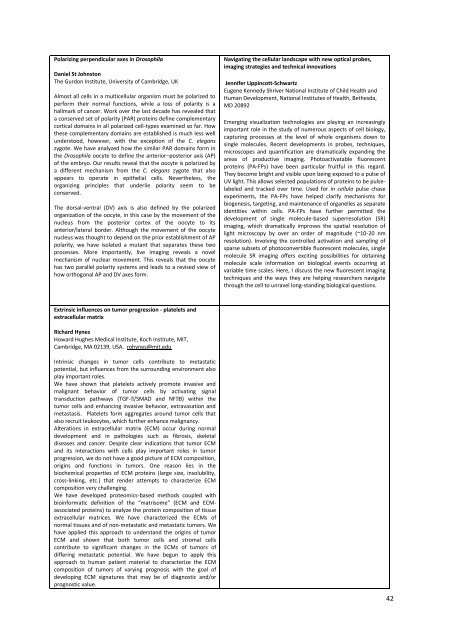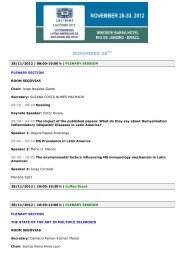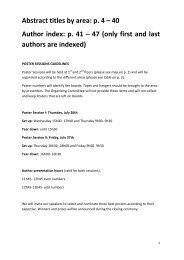Keynote Conference - Interevent
Keynote Conference - Interevent
Keynote Conference - Interevent
Create successful ePaper yourself
Turn your PDF publications into a flip-book with our unique Google optimized e-Paper software.
Polarizing perpendicular axes in Drosophila<br />
Daniel St Johnston<br />
The Gurdon Institute, University of Cambridge, UK<br />
Almost all cells in a multicellular organism must be polarized to<br />
perform their normal functions, while a loss of polarity is a<br />
hallmark of cancer. Work over the last decade has revealed that<br />
a conserved set of polarity (PAR) proteins define complementary<br />
cortical domains in all polarized cell-types examined so far. How<br />
these complementary domains are established is much less well<br />
understood, however, with the exception of the C. elegans<br />
zygote. We have analyzed how the similar PAR domains form in<br />
the Drosophila oocyte to define the anterior–posterior axis (AP)<br />
of the embryo. Our results reveal that the oocyte is polarized by<br />
a different mechanism from the C. elegans zygote that also<br />
appears to operate in epithelial cells. Nevertheless, the<br />
organizing principles that underlie polarity seem to be<br />
conserved.<br />
The dorsal-ventral (DV) axis is also defined by the polarized<br />
organization of the oocyte, in this case by the movement of the<br />
nucleus from the posterior cortex of the oocyte to its<br />
anterior/lateral border. Although the movement of the oocyte<br />
nucleus was thought to depend on the prior establishment of AP<br />
polarity, we have isolated a mutant that separates these two<br />
processes. More importantly, live imaging reveals a novel<br />
mechanism of nuclear movement. This reveals that the oocyte<br />
has two parallel polarity systems and leads to a revised view of<br />
how orthogonal AP and DV axes form.<br />
Extrinsic influences on tumor progression - platelets and<br />
extracellular matrix<br />
Richard Hynes<br />
Howard Hughes Medical Institute, Koch Institute, MIT,<br />
Cambridge, MA 02139, USA. rohynes@mit.edu<br />
Intrinsic changes in tumor cells contribute to metastatic<br />
potential, but influences from the surrounding environment also<br />
play important roles.<br />
We have shown that platelets actively promote invasive and<br />
malignant behavior of tumor cells by activating signal<br />
transduction pathways (TGF- /SMAD and NF B) within the<br />
tumor cells and enhancing invasive behavior, extravasation and<br />
metastasis. Platelets form aggregates around tumor cells that<br />
also recruit leukocytes, which further enhance malignancy.<br />
Alterations in extracellular matrix (ECM) occur during normal<br />
development and in pathologies such as fibrosis, skeletal<br />
diseases and cancer. Despite clear indications that tumor ECM<br />
and its interactions with cells play important roles in tumor<br />
progression, we do not have a good picture of ECM composition,<br />
origins and functions in tumors. One reason lies in the<br />
biochemical properties of ECM proteins (large size, insolubility,<br />
cross-linking, etc.) that render attempts to characterize ECM<br />
composition very challenging.<br />
We have developed proteomics-based methods coupled with<br />
bioinformatic definition of the “matrisome” (ECM and ECMassociated<br />
proteins) to analyze the protein composition of tissue<br />
extracellular matrices. We have characterized the ECMs of<br />
normal tissues and of non-metastatic and metastatic tumors. We<br />
have applied this approach to understand the origins of tumor<br />
ECM and shown that both tumor cells and stromal cells<br />
contribute to significant changes in the ECMs of tumors of<br />
differing metastatic potential. We have begun to apply this<br />
approach to human patient material to characterize the ECM<br />
composition of tumors of varying prognosis with the goal of<br />
developing ECM signatures that may be of diagnostic and/or<br />
prognostic value.<br />
Navigating the cellular landscape with new optical probes,<br />
imaging strategies and technical innovations<br />
Jennifer Lippincott-Schwartz<br />
Eugene Kennedy Shriver National Institute of Child Health and<br />
Human Development, National Institutes of Health, Bethesda,<br />
MD 20892<br />
Emerging visualization technologies are playing an increasingly<br />
important role in the study of numerous aspects of cell biology,<br />
capturing processes at the level of whole organisms down to<br />
single molecules. Recent developments in probes, techniques,<br />
microscopes and quantification are dramatically expanding the<br />
areas of productive imaging. Photoactivatable fluorescent<br />
proteins (PA-FPs) have been particular fruitful in this regard.<br />
They become bright and visible upon being exposed to a pulse of<br />
UV light. This allows selected populations of proteins to be pulselabeled<br />
and tracked over time. Used for in cellulo pulse chase<br />
experiments, the PA-FPs have helped clarify mechanisms for<br />
biogenesis, targeting, and maintenance of organelles as separate<br />
identities within cells. PA-FPs have further permitted the<br />
development of single molecule-based superresolution (SR)<br />
imaging, which dramatically improves the spatial resolution of<br />
light microscopy by over an order of magnitude (~10-20 nm<br />
resolution). Involving the controlled activation and sampling of<br />
sparse subsets of photoconvertible fluorescent molecules, single<br />
molecule SR imaging offers exciting possibilities for obtaining<br />
molecule scale information on biological events occurring at<br />
variable time scales. Here, I discuss the new fluorescent imaging<br />
techniques and the ways they are helping researchers navigate<br />
through the cell to unravel long-standing biological questions.<br />
42





